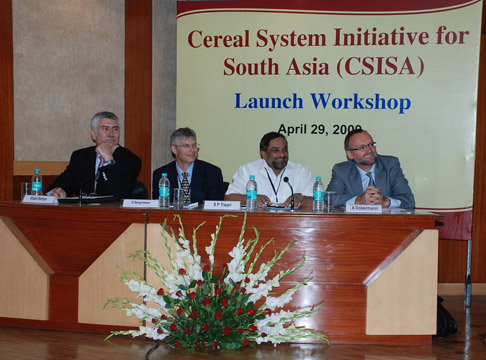Matthew Reynolds talks about climate change
The US government has temporarily satisfied its hunger for information on how to adapt agriculture to climate change. On 14 September 2009, Matthew Reynolds, CIMMYT wheat physiologist, joined around 15 other agriculture experts just outside of Washington, DC, USA, to present at a conference titled: “Adapting Agriculture to Climate Change: What Will It Take?”
The conference, sponsored by the US Department of State, opened with a keynote by John Holdren, science adviser to the President of the United States, and was followed by four main panel topics: Impacts of Climate Change on Agriculture; Research in the Public Sector; Research in the Private Sector; and Alternative Crops, Sustainable Management, and Integrative Strategies. The goal of the event was to explore strategies and raise awareness about adaption measures that are required—or will be required in the future—to maintain sufficient global food production.
“It is reassuring to know that the US government is taking the issue of food security in the context of climate change seriously,” said Reynolds, who presented on adapting the major cereal crops (including maize and wheat) to climate change. “The State Department was not the only government program represented at the conference; the broad spectrum of speakers and government officials (including USDA and USAID) present shows that they are considering a comprehensive approach to the issue.”
A position paper based on the outcomes of the conference will be prepared for the US government. It will also be published in Science magazine.
 The Cereal Systems Initiative for South Asia (CSISA) was formally initiated 29 April 2009 in Delhi, India. This large project, which is jointly funded by the Bill & Melinda Gates Foundation and USAID, brings together public- and private-sector organizations and international agricultural research centers (IRRI, CIMMYT, IFPRI, and ILRI) to reduce hunger and increase food and income security for resource-poor farm families in South Asia. The launch of this project comes at a critical time for South Asia, home to 40% of the world’s poor with nearly half a billion people subsisting on less than USD 1 a day. The project’s targeted countries of Bangladesh, India, Nepal, and Pakistan are struggling to boost grain supplies in the wake of growing demand and strained natural resources. CSISA aims to increase the cereal crop yields of at least 6 million farmers in these regions by at least 0.5 t/ha. With this huge task ahead, time is precious and so many parallel planning activities and interviews for local staff positions were conducted alongside the launch to speed the project’s progress.
The Cereal Systems Initiative for South Asia (CSISA) was formally initiated 29 April 2009 in Delhi, India. This large project, which is jointly funded by the Bill & Melinda Gates Foundation and USAID, brings together public- and private-sector organizations and international agricultural research centers (IRRI, CIMMYT, IFPRI, and ILRI) to reduce hunger and increase food and income security for resource-poor farm families in South Asia. The launch of this project comes at a critical time for South Asia, home to 40% of the world’s poor with nearly half a billion people subsisting on less than USD 1 a day. The project’s targeted countries of Bangladesh, India, Nepal, and Pakistan are struggling to boost grain supplies in the wake of growing demand and strained natural resources. CSISA aims to increase the cereal crop yields of at least 6 million farmers in these regions by at least 0.5 t/ha. With this huge task ahead, time is precious and so many parallel planning activities and interviews for local staff positions were conducted alongside the launch to speed the project’s progress.